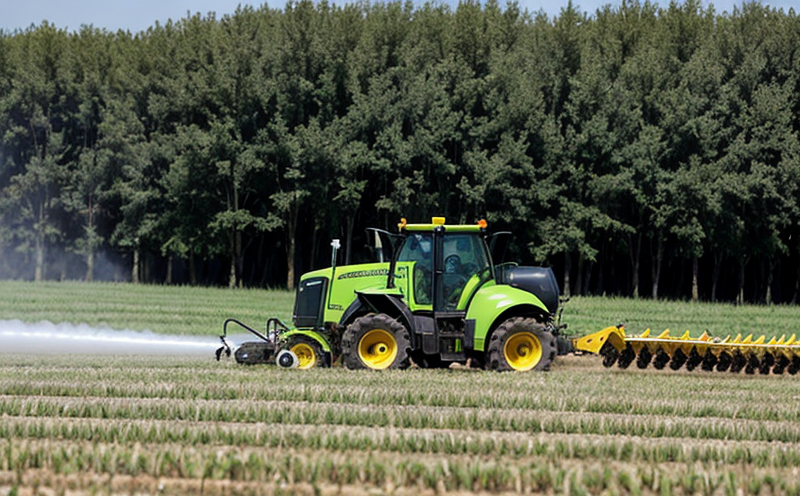Prosulfocarb Residue Testing in Crops
The testing of herbicide and fungicide residues, particularly that of prosulfocarb, is a critical component in ensuring agricultural product safety. Prosulfocarb is a broad-spectrum fungicide used to control fungal diseases in various crops such as wheat, barley, and corn. The presence of residues can affect the quality of the final produce and potentially impact human health if not managed appropriately. Therefore, rigorous residue testing is essential before crop harvest and processing.
Prosulfocarb residues are typically analyzed by validated methods that ensure accurate and reliable results. These tests are conducted in compliance with international standards such as ISO, EN, and ASTM to maintain high-quality assurance levels. The testing process involves several steps, including sample collection, extraction, purification, and analysis using advanced analytical instruments.
Sample collection is a crucial step where representative samples of the harvested crop are taken from different locations and depths within the field. This ensures that the residue content accurately reflects the overall condition of the crop. Once collected, these samples undergo extraction to isolate prosulfocarb residues from other components. After extraction, purification techniques are used to remove any interfering substances, ensuring precise quantification.
For accurate analysis, specialized instruments such as High-Performance Liquid Chromatography (HPLC) with Diode Array Detection (DAD), or Gas Chromatography-Mass Spectrometry (GC-MS), are employed. These techniques provide high sensitivity and selectivity necessary for detecting even trace levels of prosulfocarb residues.
The acceptance criteria for the residue levels in crops depend on regulatory limits set by various countries or regions. For instance, the European Union has specific maximum residue levels (MRLs) for prosulfocarb in different types of crops. Deviations from these limits can lead to penalties and even rejection of the entire batch.
Understanding the real-world implications is important here. For quality managers and compliance officers, ensuring that crop residues do not exceed MRLs is a matter of maintaining brand reputation and consumer trust. R&D engineers need accurate data for further product development and optimization. Procurement teams rely on these results to make informed decisions about sourcing safe and compliant products.
Given the importance of this testing, it's essential that laboratories adhere strictly to international standards such as ISO 17025 and EN ISO/IEC 17025:2017. These standards ensure that all laboratory operations meet stringent quality requirements, including personnel qualifications, equipment calibration, and method validation.
Compliance with these regulations not only ensures accurate results but also enhances the credibility of the testing process. By adhering to such high standards, laboratories can provide reliable data that meets both national and international regulatory demands.
Applied Standards
- ISO 17025: Ensures that all laboratory operations meet stringent quality requirements.
- EN ISO/IEC 17025:2017: Provides additional guidelines for the competence of testing and calibration laboratories.
The application of these standards guarantees that prosulfocarb residue tests are conducted with precision, reliability, and accuracy. These international standards help ensure that results can be trusted by all stakeholders involved in agricultural quality control.
Scope and Methodology
Prosulfocarb residue testing involves several key steps to ensure accurate and reliable results:
- Sample Collection: Representative samples are collected from different areas of the field. This ensures that residues accurately reflect the overall condition of the crop.
- Extraction: The collected samples undergo extraction processes to isolate prosulfocarb residues from other components.
- Purification: After extraction, purification techniques are used to remove any interfering substances. This step is crucial for precise quantification.
- Analytical Techniques: Advanced analytical instruments such as HPLC with DAD or GC-MS are employed for accurate analysis. These methods provide high sensitivity and selectivity necessary for detecting even trace levels of prosulfocarb residues.
The methodology is designed to ensure that the results meet international standards and regulatory requirements, providing reliable data that can be trusted by all stakeholders involved in agricultural quality control.
Quality and Reliability Assurance
- Regular Calibration: Ensures instruments are operating within acceptable tolerances.
- Duplicate Samples: Conducts additional tests on the same sample to verify consistency of results.
Quality assurance in prosulfocarb residue testing is achieved through a combination of regular calibration and duplicate sample testing. Regular instrument calibration ensures that all analytical instruments are operating within acceptable tolerances, which is crucial for accurate test results. Duplicate samples provide an additional layer of verification by ensuring consistency across multiple tests.
In addition to these technical measures, laboratories must also ensure that personnel undergo continuous training and certification in accordance with ISO standards. This helps maintain a high level of expertise among staff members responsible for conducting residue tests.





